2005 SUBARU BAJA ignition
[x] Cancel search: ignitionPage 245 of 469
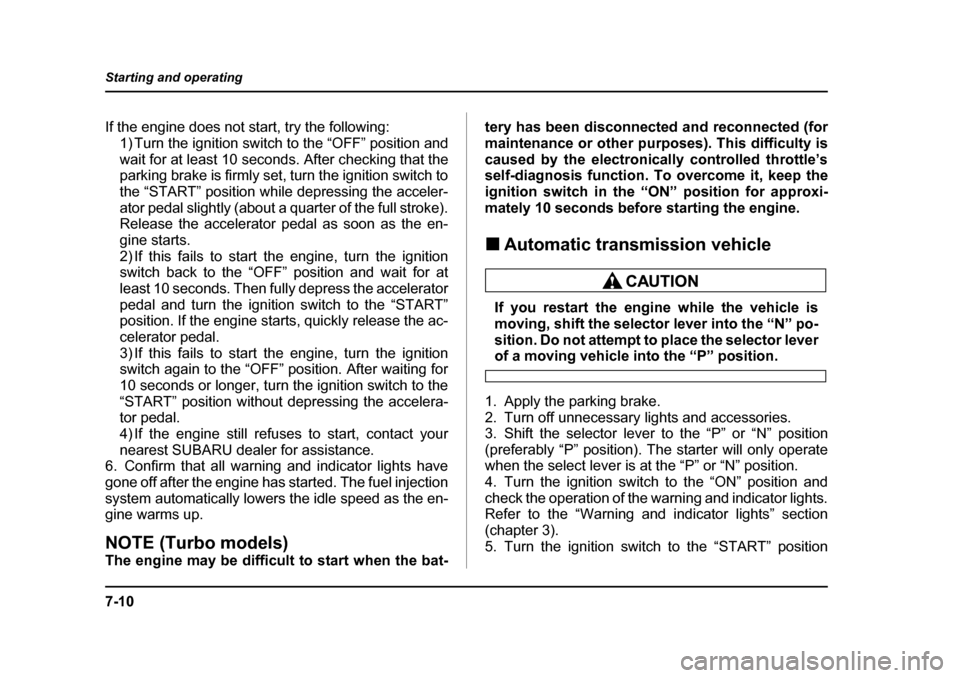
7-10
Starting and operating
If the engine does not start, try the following:
1) Turn the ignition switch to the “OFF” position and
wait for at least 10 seconds. After checking that the
parking brake is firmly set, turn the ignition switch to
the “START” position while depressing the acceler-
ator pedal slightly (about a quarter of the full stroke).
Release the accelerator pedal as soon as the en-
gine starts.
2) If this fails to start the engine, turn the ignition
switch back to the “OFF” position and wait for at
least 10 seconds. Then fully depress the accelerator
pedal and turn the ignition switch to the “START”
position. If the engine starts, quickly release the ac-
celerator pedal.
3) If this fails to start the engine, turn the ignition
switch again to the “OFF” position. After waiting for
10 seconds or longer, turn the ignition switch to the
“START” position without depressing the accelera-
tor pedal.
4) If the engine still refuses to start, contact your
nearest SUBARU dealer for assistance.
6. Confirm that all warning and indicator lights have
gone off after the engine has started. The fuel injection
system automatically lowers the idle speed as the en-
gine warms up.
NOTE (Turbo models)
The engine may be difficult to start when the bat- tery has been disconnected and reconnected (for
maintenance or other purposes). This difficulty is
caused by the electronically controlled throttle’s
self-diagnosis function. To overcome it, keep the
ignition switch in the “ON” position for approxi-
mately 10 seconds before starting the engine. �„
Automatic transmission vehicle
If you restart the engine while the vehicle is
moving, shift the selector lever into the “N” po-
sition. Do not attempt to place the selector lever
of a moving vehicle into the “P” position.
1. Apply the parking brake.
2. Turn off unnecessary lights and accessories.
3. Shift the selector lever to the “P” or “N” position
(preferably “P” position). The starter will only operate
when the select lever is at the “P” or “N” position.
4. Turn the ignition switch to the “ON” position and
check the operation of the warning and indicator lights.
Refer to the “Warning and indicator lights” section
(chapter 3).
5. Turn the ignition switch to the “START” position
Page 246 of 469
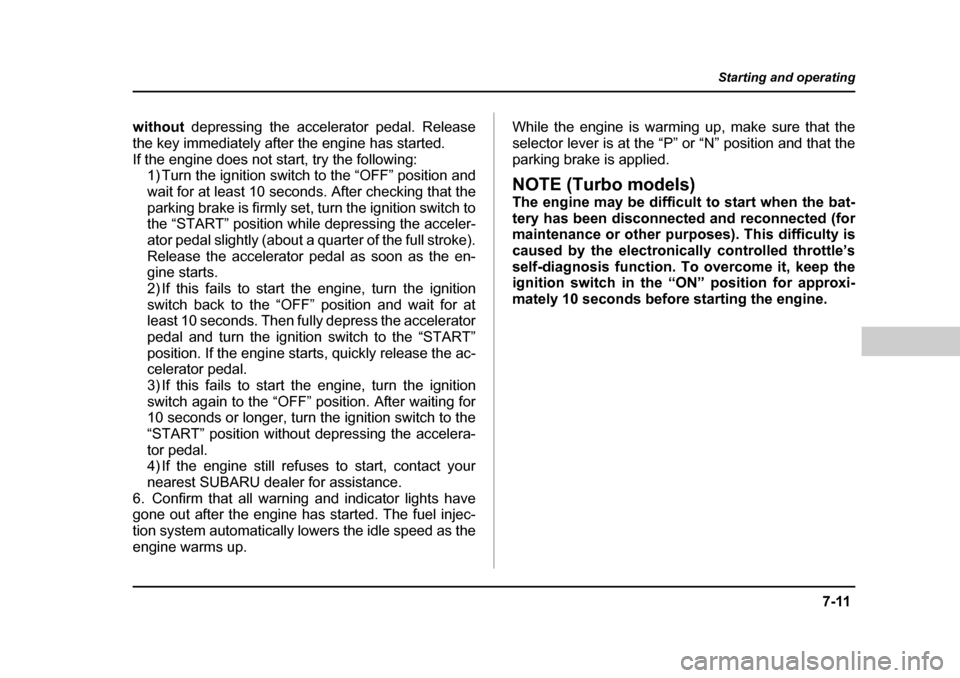
7-11
Starting and operating
– CONTINUED –
without depressing the accelerator pedal. Release
the key immediately after the engine has started.
If the engine does not start, try the following: 1) Turn the ignition switch to the “OFF” position and
wait for at least 10 seconds. After checking that the
parking brake is firmly set, turn the ignition switch to
the “START” position while depressing the acceler-
ator pedal slightly (about a quarter of the full stroke).
Release the accelerator pedal as soon as the en-
gine starts.
2) If this fails to start the engine, turn the ignition
switch back to the “OFF” position and wait for at
least 10 seconds. Then fully depress the accelerator
pedal and turn the ignition switch to the “START”
position. If the engine starts, quickly release the ac-
celerator pedal.
3) If this fails to start the engine, turn the ignition
switch again to the “OFF” position. After waiting for
10 seconds or longer, turn the ignition switch to the
“START” position without depressing the accelera-
tor pedal.
4) If the engine still refuses to start, contact your
nearest SUBARU dealer for assistance.
6. Confirm that all warning and indicator lights have
gone out after the engine has started. The fuel injec-
tion system automatically lowers the idle speed as the
engine warms up. While the engine is warming up, make sure that the
selector lever is at the “P” or “N” position and that the
parking brake is applied.
NOTE (Turbo models)
The engine may be difficult to start when the bat-
tery has been disconnected and reconnected (for
maintenance or other purposes). This difficulty is
caused by the electronically controlled throttle’s
self-diagnosis function. To overcome it, keep the
ignition switch in the “ON” position for approxi-
mately 10 seconds before starting the engine.
Page 247 of 469
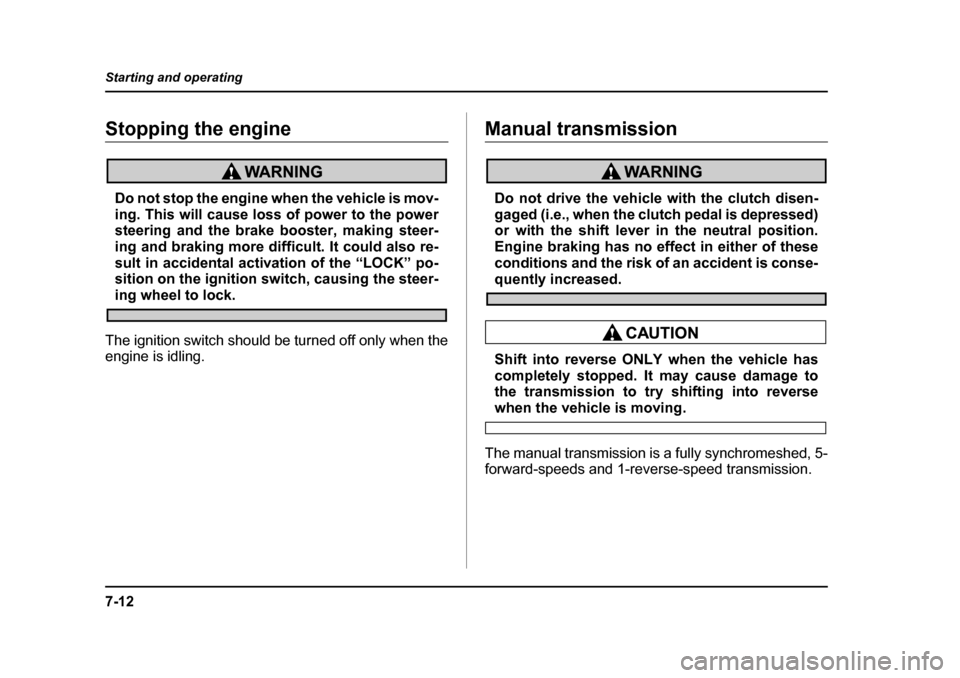
7-12
Starting and operating
Stopping the engine
Do not stop the engine when the vehicle is mov-
ing. This will cause loss of power to the power
steering and the brake booster, making steer-
ing and braking more difficult. It could also re-
sult in accidental activation of the “LOCK” po-
sition on the ignition switch, causing the steer-
ing wheel to lock.
The ignition switch should be turned off only when the
engine is idling.
Manual transmission
Do not drive the vehicle with the clutch disen-
gaged (i.e., when the clutch pedal is depressed)
or with the shift lever in the neutral position.
Engine braking has no effect in either of these
conditions and the risk of an accident is conse-
quently increased.
Shift into reverse ONLY when the vehicle has
completely stopped. It may cause damage to the transmission to try shifting into reverse
when the vehicle is moving.
The manual transmission is a fully synchromeshed, 5-
forward-speeds and 1-reverse-speed transmission.
Page 252 of 469
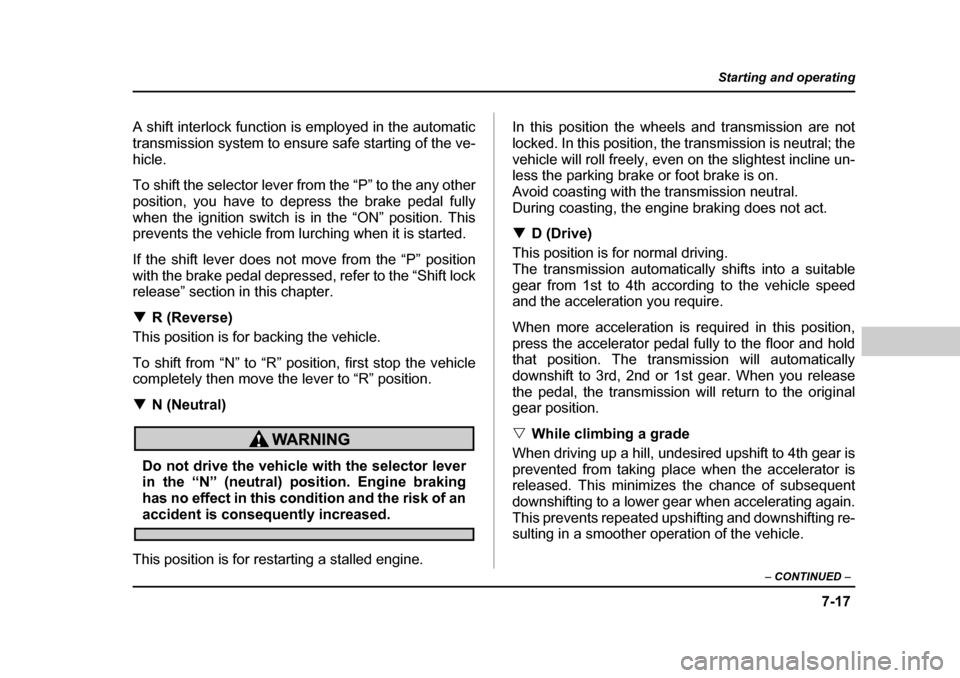
7-17
Starting and operating
– CONTINUED –
A shift interlock function is employed in the automatic
transmission system to ensure safe starting of the ve-
hicle.
To shift the selector lever from the “P” to the any other
position, you have to depress the brake pedal fully
when the ignition switch is in the “ON” position. This
prevents the vehicle from lurching when it is started.
If the shift lever does not move from the “P” position
with the brake pedal depressed, refer to the “Shift lock
release” section in this chapter. �TR (Reverse)
This position is for backing the vehicle.
To shift from “N” to “R” position, first stop the vehicle
completely then move the lever to “R” position. �T N (Neutral)
Do not drive the vehicle with the selector lever
in the “N” (neutral) position. Engine braking
has no effect in this condition and the risk of an
accident is consequently increased.
This position is for restarting a stalled engine. In this position the wheels and transmission are not
locked. In this position, the transmission is neutral; the
vehicle will roll freely, even on the slightest incline un-
less the parking brake or foot brake is on.
Avoid coasting with the transmission neutral.
During coasting, the engine braking does not act. �T
D (Drive)
This position is for normal driving.
The transmission automatically shifts into a suitable
gear from 1st to 4th according to the vehicle speed
and the acceleration you require.
When more acceleration is required in this position,
press the accelerator pedal fully to the floor and hold
that position. The transmission will automatically
downshift to 3rd, 2nd or 1st gear. When you release
the pedal, the transmission will return to the original
gear position. �V While climbing a grade
When driving up a hill, undesired upshift to 4th gear is
prevented from taking place when the accelerator is
released. This minimizes the chance of subsequent
downshifting to a lower gear when accelerating again.
This prevents repeated upshifting and downshifting re-
sulting in a smoother operation of the vehicle.
Page 255 of 469
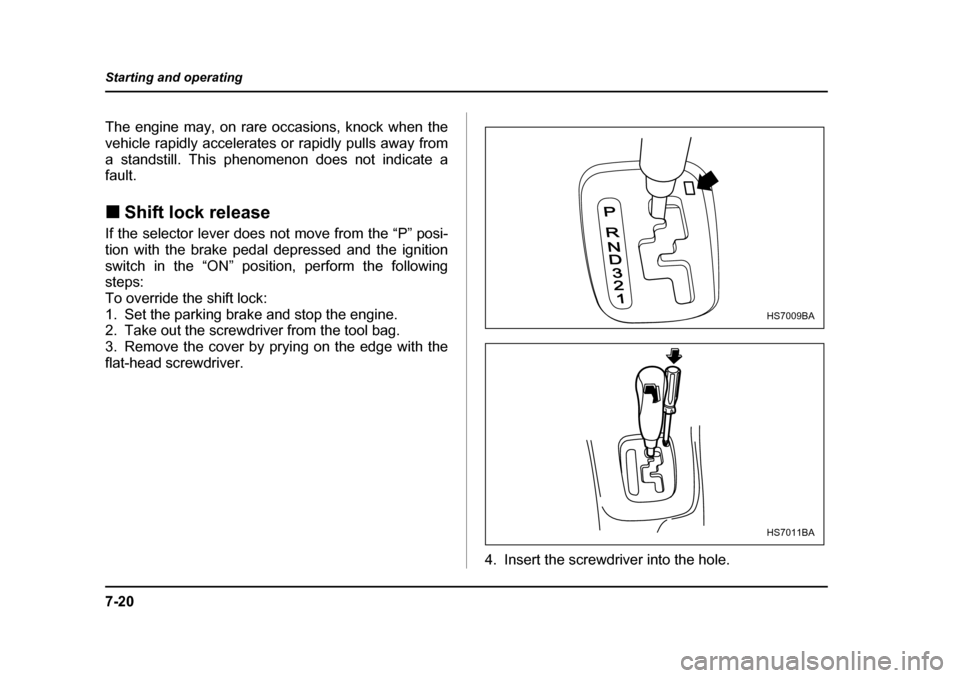
7-20
Starting and operating
The engine may, on rare occasions, knock when the
vehicle rapidly accelerates or rapidly pulls away from
a standstill. This phenomenon does not indicate a fault. �„
Shift lock release
If the selector lever does not move from the “P” posi-
tion with the brake pedal depressed and the ignition
switch in the “ON” position, perform the following steps:
To override the shift lock:
1. Set the parking brake and stop the engine.
2. Take out the screwdriver from the tool bag.
3. Remove the cover by prying on the edge with the
flat-head screwdriver.
4. Insert the screwdriver into the hole.
P
RND321
HS7009BA
HS7011BA
Page 258 of 469
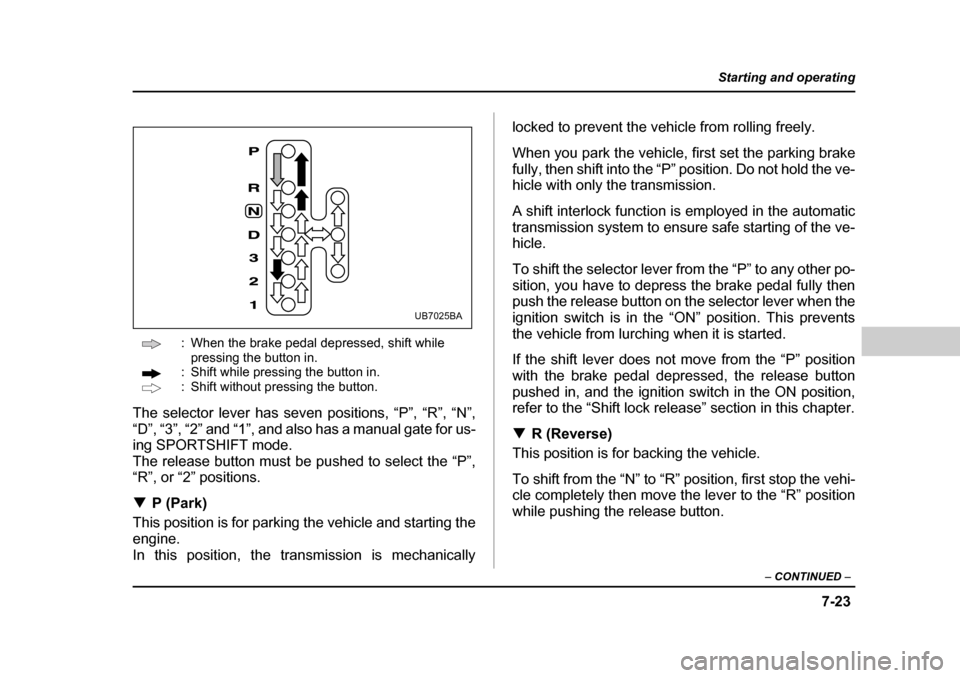
7-23
Starting and operating
– CONTINUED –
: When the brake pedal depressed, shift while
pressing the button in.
: Shift while pressing the button in.
: Shift without pressing the button.
The selector lever has seven positions, “P”, “R”, “N”,
“D”, “3”, “2” and “1”, and also has a manual gate for us-
ing SPORTSHIFT mode.
The release button must be pushed to select the “P”,
“R”, or “2” positions. �T P (Park)
This position is for parking the vehicle and starting the
engine.
In this position, the transmission is mechanically locked to prevent the vehicle from rolling freely.
When you park the vehicle, first set the parking brake
fully, then shift into the “P” position. Do not hold the ve-
hicle with only the transmission.
A shift interlock function is employed in the automatic
transmission system to ensure safe starting of the ve-
hicle.
To shift the selector lever from the “P” to any other po-
sition, you have to depress the brake pedal fully then
push the release button on the selector lever when the
ignition switch is in the “ON” position. This prevents
the vehicle from lurching when it is started.
If the shift lever does not move from the “P” position
with the brake pedal depressed, the release button
pushed in, and the ignition switch in the ON position,
refer to the “Shift lock release” section in this chapter. �T
R (Reverse)
This position is for backing the vehicle.
To shift from the “N” to “R” position, first stop the vehi-
cle completely then move the lever to the “R” position
while pushing the release button.
UB7025BA
Page 259 of 469
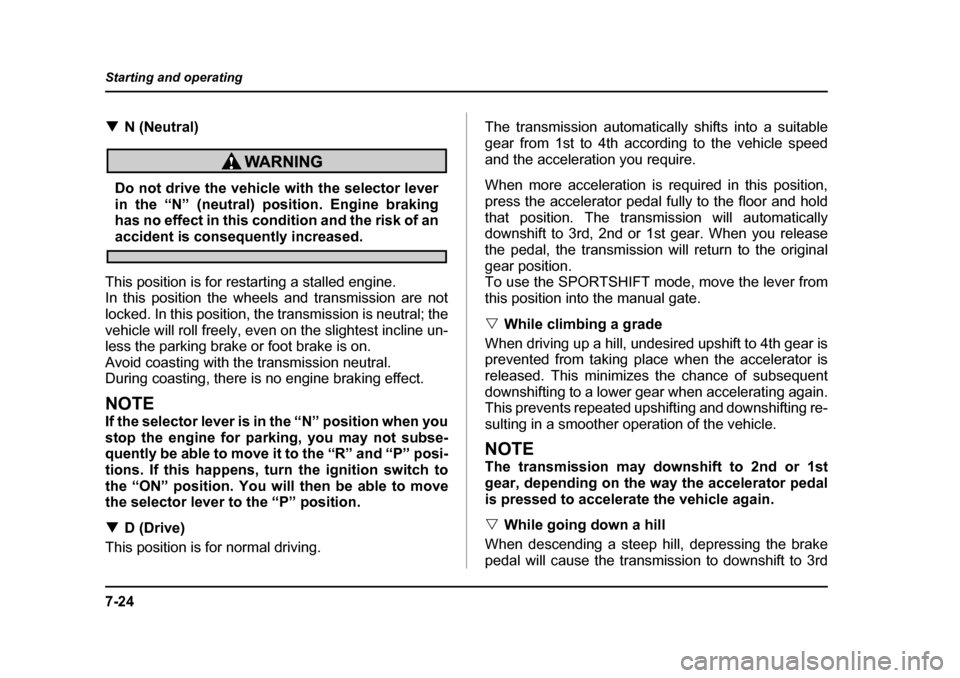
7-24
Starting and operating
�T
N (Neutral)
Do not drive the vehicle with the selector lever
in the “N” (neutral) position. Engine braking
has no effect in this condition and the risk of an
accident is consequently increased.
This position is for restarting a stalled engine.
In this position the wheels and transmission are not
locked. In this position, the transmission is neutral; the
vehicle will roll freely, even on the slightest incline un-
less the parking brake or foot brake is on.
Avoid coasting with the transmission neutral.
During coasting, there is no engine braking effect.
NOTE
If the selector lever is in the “N” position when you
stop the engine for parking, you may not subse-
quently be able to move it to the “R” and “P” posi- tions. If this happens, turn the ignition switch to
the “ON” position. You will then be able to move
the selector lever to the “P” position. �T D (Drive)
This position is for normal driving. The transmission automatically shifts into a suitable
gear from 1st to 4th according to the vehicle speed
and the acceleration you require.
When more acceleration is required in this position,
press the accelerator pedal fully to the floor and hold
that position. The transmission will automatically
downshift to 3rd, 2nd or 1st gear. When you release
the pedal, the transmission will return to the original
gear position.
To use the SPORTSHIFT mode, move the lever from
this position into the manual gate. �V
While climbing a grade
When driving up a hill, undesired upshift to 4th gear is
prevented from taking place when the accelerator is
released. This minimizes the chance of subsequent
downshifting to a lower gear when accelerating again.
This prevents repeated upshifting and downshifting re-
sulting in a smoother operation of the vehicle.
NOTE
The transmission may downshift to 2nd or 1st
gear, depending on the way the accelerator pedal
is pressed to accelerate the vehicle again. �V While going down a hill
When descending a steep hill, depressing the brake
pedal will cause the transmission to downshift to 3rd
Page 261 of 469
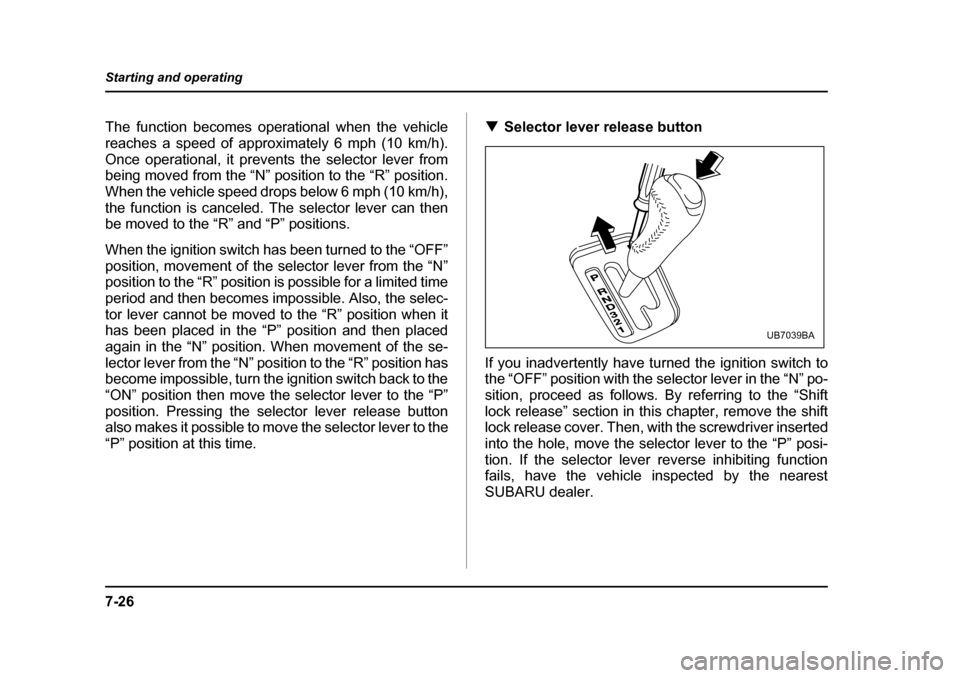
7-26
Starting and operating
The function becomes operational when the vehicle
reaches a speed of approximately 6 mph (10 km/h).
Once operational, it prevents the selector lever from
being moved from the “N” position to the “R” position.
When the vehicle speed drops below 6 mph (10 km/h),
the function is canceled. The selector lever can then
be moved to the “R” and “P” positions.
When the ignition switch has been turned to the “OFF”
position, movement of the selector lever from the “N”
position to the “R” position is possible for a limited time
period and then becomes impossible. Also, the selec-
tor lever cannot be moved to the “R” position when it
has been placed in the “P” position and then placed
again in the “N” position. When movement of the se-
lector lever from the “N” position to the “R” position has
become impossible, turn the ignition switch back to the
“ON” position then move the selector lever to the “P”
position. Pressing the selector lever release button
also makes it possible to move the selector lever to the
“P” position at this time.
�T
Selector lever release button
If you inadvertently have turned the ignition switch to
the “OFF” position with the selector lever in the “N” po-
sition, proceed as follows. By referring to the “Shift
lock release” section in this chapter, remove the shift
lock release cover. Then, with the screwdriver inserted
into the hole, move the selector lever to the “P” posi-
tion. If the selector lever reverse inhibiting function
fails, have the vehicle inspected by the nearest SUBARU dealer.
UB7039BA